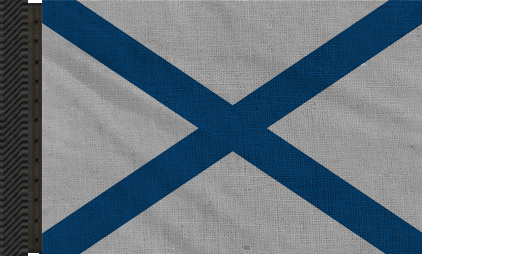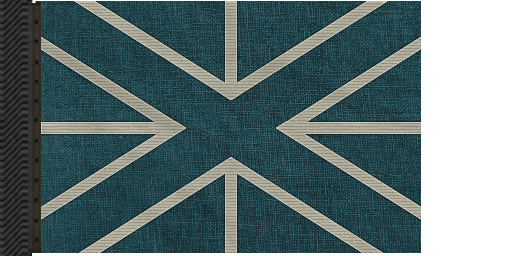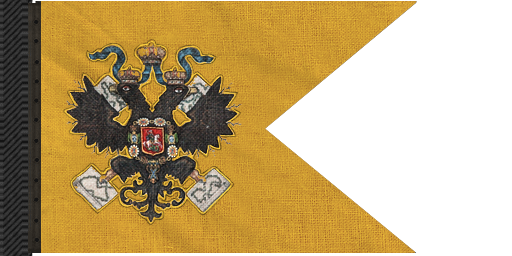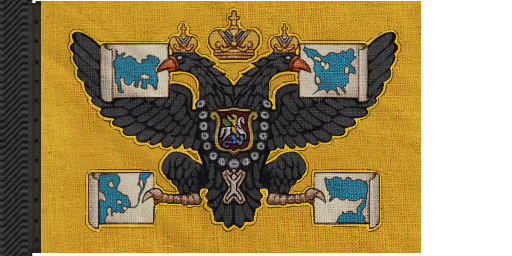FLAGS OF russia
Russian Empire national Flag
The flag of the Imperial Russian Navy. The flag was established by Peter the Great in the beginning of the eighteenth century after a decent amount of sketches of the flag drawn by himself. It was used on ships arriving or built in the Americas. The flag represents a blue Saint Andrew Cross on a white background.
Andrew's Cross Blue Flag
The naval jack of the Imperial Russian Navy commissioned in 1772. The flag represents a variation of reversed color Saint Andrew Cross - a narrow white cross and a white-bordered dark blue Saint Andrew Cross on a dark blue background.
Azov Fleet Flag
The flag of Goto Predestinatsia - the first Russian ship of the line entirely built within the Empire by Russian shipbuilders. This is one of proposed designs for flags created by Peter the Great circa 1698-1701 years. The flag consists of three white, blue and red stripes on the upper and lower edges and a blue Saint Andrew cross fitted in between.
Blue Ensign
The blue flag of the Vanguard. Peter the Great divided Russian fleet into three formations: Main fleet, Vanguard and Rear Guard. The Vanguard was given a blue flag with the blue Saint Andrew Cross on a white background in the upper left quarter.
First Moscovy Flag
A variation of the flag known as the second flag of Czar of Moscovia. It was created by Peter the Great circa 1699-1700 years. This variation represents white-blue-white stripes instead of Russian tricolor and a Saint Andrew cross over it.
Galley Ensign
The forked flag of the Baltic galley squadron. The flag was introduced in the very beginning of the eighteenth century under the reign of Peter the Great. The flag consists of a small St. Andrew Cross in the upper left quarter on a red background.
Galley Flag
The flag of the Russian galley fleet. The flag was introduced in the first half of the eighteenth century. The flag consists of a narrow white cross and a narrow white Saint Andrew Cross on a red background.
Guis Flag
The Russian naval jack was hoisted on the bowsprit of ships belonging to the Imperial Russian Navy since the beginning of eighteen century; sometimes it was used on fortifications as well. Like many other Russian naval flags, it was drawn by Peter the Great. The jack represents a narrow white cross and a white-bordered blue Saint Andrew Cross on a red background.
Imperial Ensign
The standard of the Emperor for the Galley fleet. The standard indicates the presence of the Russian emperor aboard and was commissioned once the Russian Empire got access to the Black Sea. It has a forked shape and consists of a the black double-headed eagle with maps in his claws and beaks on a yellow background. Maps show seas that surround the Russian Empire - Baltic Sea, White Sea, Black Sea and Caspian Sea.
Imperial Flag
The standard of the Emperor for the main fleet. The standard indicates the presence of the Russian emperor aboard and was commissioned once the Russian Empire got access to the Black Sea. It consists of a the black double-headed eagle with maps in his claws and beaks on a yellow background. Maps show seas that surround the Russian Empire - Baltic Sea, White Sea, Black Sea and Caspian Sea.
Peter Yacht Flag
The personal flag of Peter the Great that was hoisted on his yacht in 1693. The flag represents Russian tricolor with a widened central blue stripe fitted with the double-headed eagle and a crown.
Peter's Standard
The personal standard of the emperor Peter the Great that was hoisted on the ship of the line Ingermanland in 1716. The standard indicates the presence of Peter the Great aboard. It consists of a the black double-headed eagle with maps in his claws and beaks on a yellow background. Maps show seas that surround the Russian Empire - White Sea, Caspian Sea, Sea of Azov and Baltic Sea.
Peter's Standard Wide
The personal standard of the emperor Peter the Great. The standard indicates the presence of Peter the Great aboard. It consists of a the black double-headed eagle with maps in his claws and beaks on a yellow background. Maps show seas that surround the Russian Empire - White Sea, Caspian Sea, Sea of Azov and Baltic Sea.
Red Ensign
The red flag of the Rear Guard. Peter the Great divided Russian fleet into three formations: Main fleet, Vanguard and Rear Guard. The Rear Guard was given a red flag with the blue Saint Andrew Cross on a white background in the upper left quarter.
Russian-American Company Flag
The flag of Russian-American Company was established by Emperor Paul I of Russia by the end of eighteen century to maintain overseas territories in the Americas. The flag represents Russian tricolor theme with an enlarged upper white stripe and the imperial eagle in the upper left part of the flag.
Second Moscovy Flag
The flag is known as the second flag of Czar of Moscovia. It was created by Peter the Great circa 1699-1700 years. The flag represents Russian tricolor with a Saint Andrew cross over it.
Tartaria Flag
The flag of Tartaria - this flag is mostly used by subjects of the Russian crown of Tatarian origin from the former Khanate of Kazan. The flag represents a black mythic dragon-like creature on a yellow background.
Third Moscovy Flag
The flag is believed to be one of the first naval flags of Tsardom of Russia commissioned by Alexis I The Quietest - the father of Peter the Great. It must have been used on ships during the conquest of Azov. The flag is divided in four quarters, the first and fourth are white and the second and the third are red, with a blue cross over all.
Tricolor Flag
The flag of Apostol Piotr - a Russian galleass that was a part of the Azov flotilla. This is one of proposed designs for flags created by Peter the Great circa 1698-1701 years. The flag consists of two Russian tricolors - white, blue and red stripes.
White Ensign
The white flag of the Main Fleet. Peter the Great divided Russian fleet into three formations: Main fleet, Vanguard and Rear Guard. The Main Fleet was given a white flag with the blue Saint Andrew Cross in the upper left quarter.
Kronštádt Flag
The flag of Russian revolutionary sailors from Kronstadt. Their purposes remain uncertain but judging on the flag they don’t like wealthy and noble foreigners.




















